What is the origin natural silk?!
For the first time on natural silk began in ancient China in the 3rd Millennium BC. There is a legend that one day then walking in the spring Park a little brilliant lump fell from the tree on the daughter of the Chinese Emperor. The girl was interested in him and took him to his father. From the moment when an interest is appeared for strange cocoons the cocoon production of silkworm began to develop.
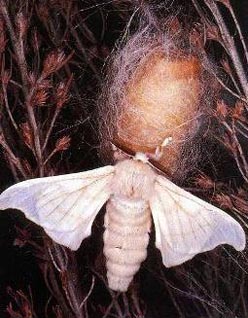
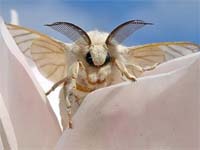
White shiny ball - this is the finest thread natural silk. It is built by the caterpillar silkworm. The caterpillar has two antennae on the head, which (as glands) that produce secretions, which harden and become silk thread.
Silkworm builds a cocoon around themselves with a diameter of about 2 cm and a length of 3.5 cm. The thickness of the silk thread is only 0.02 mm, which is several times thinner than hair. If unwinding the cocoon of the silkworm, we get a thin thread approximately 3.5 km (3500 m). With such a thickness thread, of course, to work is not convenient, so usually before to work curl several threads into one.
Natural silk, as you may have guessed - is a complex organic substance with protein origin. It mainly consists of residues of molecules amino acids, tyrosine and aniline. Chemical formula of natural silk C15H23N5O6, which corresponds to chemical substance fibroin (from the Latin - fibra (fiber)).
In the initial stages of development of silk production used natural raw materials - cocoons of silkworms! And imagine, the labor of unwinding of such threads were not mechanized. But despite the fact that in the middle of the 20th century was created the mechanisms for the unwinding of cocoons, but price of silk production is still down slightly! (for comparison, one unit of silk products were paid 400 times more than wheat in the same quantity by weight).
The proposal to receive artificial silk was first described in the scientific work of one of the French scientists rene Antoine Reaumur) in the mid-18th century. Studying insects, it is suggested that it is possible chemically to create a solution that would allow to extract from him a thin thread, suitable for machine.
But practically his idea was realized only in the second half of the 19th century by French chemist (Louis Chardonnay)! Raw materials for the manufacture of artificial silk was cellulose and another complex chemical substance polysaccharide. Acting with nitric acid to these materials got nitrocellulose, with chemical composition (C6H7O2(OH)3_x(ONO2)x)n. This substance can be dissolved in a mixture of alcohol and ether, and extract from him the thin filaments.
In the early 20th century his small factory produced up to 1,000 tonnes of artificial silk per year.
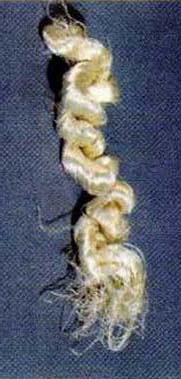
Louis Chardonnay was passed through a very thin tubes pre-warmed solution of nitrocellulose. The resulting streams fell into the cold water and froze there in thin threads. These silk threads automatically wound on the spool. When added to a solution of nitrocellulose any dye you can receive artificial silk with different colors.
Later the technology was modified: instead of water was used warm air, thus became possible to save the alcohol and ether. Later from nitrocellulose became to get a plastic celluloid.
Nitrocellulose is a substance that ignites and burns perfectly, and also has explosive properties. This substance may exist in different modifications. Depending on the number of nitro groups that are included in the nitrocellulose, there are the following substances: colloxylin ( with a small number of nitro groups), pyroxylin (with the increased number of nitro groups). The resulting substance is widely used for the manufacture of dynamite and smokeless gunpowder. It is known that the clothes are made from nitrocellulose instantly ignited and burned!
So, with combustible properties of tissue was developed a method to transfer of the cellulose in solution without of nitric acid! This method is based on copper-ammonium solution (call it spinning solution). But interestingly, copper-ammonia solution does not contain a single molecule of the ammonia and does not contain copper! This solution was got in the mid-19th century by Swiss scientist-chemist Matthias Edward Schweitzer. He is defined how to get th artificial silk from copper-ammonia solution. The composition of the solution - [Cu(NH3)4](OH)2 - hydroxide tetramine. Beautiful dark-blue solution has very unusual properties: at room temperature it can dissolve cotton fabric and paper, wool, silk, and, what is especially interesting - even dissolves hair!
But as it turned out, despite the fact, that starch and paper - substances similar with chemical composition, but unlike paper, the starch is not dissolved in the resulting solution.
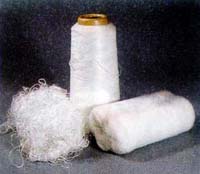
In the mid-19th century was found rather easy chemical way to obtaining hydroxide tetraamine [Cu(NH3)4](OH)2. If on small particles of copper to act ammonia (ammonium hydroxide NH4OH), the result of chemical reaction was gotthe same substance - blue solution. It was also important to consider that the reaction proceeded with a sufficient amount of oxygen (e.g., outdoors).
The chemical nature of the solution hydroxide tetraamine was explored in the mid-20th century. Then copper dissolved in ammonia, it passes into the ion state Cu2+, that forms with ammonia a beautiful complex chemical substance ammicht copper. In this solution there is also another ion (anion) (C6H8O5)2-n. It is only in a solution with a pronounced strong alkaline reaction. If to the blue solution to act any of acid then in the chemical reaction precipitates cellulose! The following reaction: nCu2++(C6H10O5)n+2nOH-↔ [CuC6H8O5]n+2nH2O.
Get a nice blue solution of hydroxide tetraamine is the basis of a new process for the production of artificial fibers in industry. First industrial getting copper-ammonia silk occurred in the early 20th century in Germany. Copper-ammonia silk is an artificial fiber, but are derived from natural substances - cellulose.
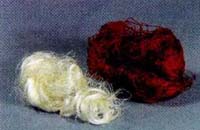
How to make a silk thread at home, using the means?!
Prepare copper sulfate CuSO4 and soda ash Na2CO3 (sold in hardware stores, may also be called washing soda).
Prepare faux malachite! Of course, not real stone, though, with chemical point, this is the same substance). Prepare a solution of copper sulfate and a solution of soda ash. Then merge them and obtain a precipitate, which will be called malachite (with the chemical point).
So, when a precipitate fell, it can be filtered from the liquid. Then it can be dissolved in concentrated ammonia (ratio like this: 2 g of sediment and 20 ml of ammonia). The resulting dark blue solution of hydroxide tetraamine copper [Cu(NH3)4](OH)2, which was first obtained in the mid-19th century. Now prepare spinning solution. To the solution put a small pieces of cotton wool. Instead of wool you can use white filter paper. Dissolve, until you get a fairly viscous solution. Now the fun part! You can pour a little bit of this spinning solution in the tube, and add a little dilute hydrochloric acid. Immediately you can see the precipitate of white flakes is a pure cellulose!
Get a thread fronm of the solution. In the syringe, dial a 10% percent solution of sulfuric acid H2SO4 and very slowly press it through the spinning solution. Get this real thread. It needs to be picked up with tweezers and placed in water. For convenience, such work is best done in wide tanks with low walls. Now the thread is ready to use. That's all! Similarly prepare artificial silk in an industrial scale. The difference may be that instead of dark blue solution use other spinning solutions, in this case, instead of the cellulose use ethers. As a result of these reactions form a variety of viscose and acetate fabrics.